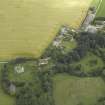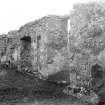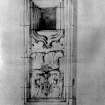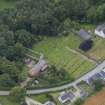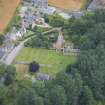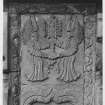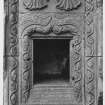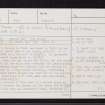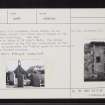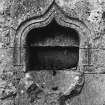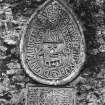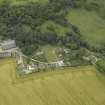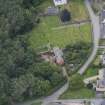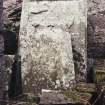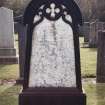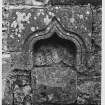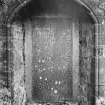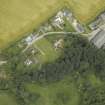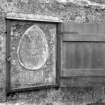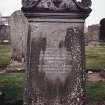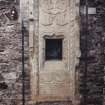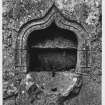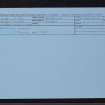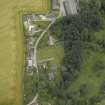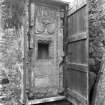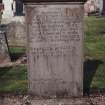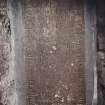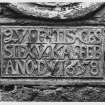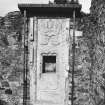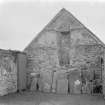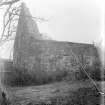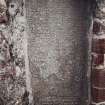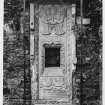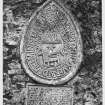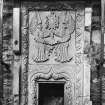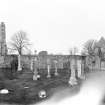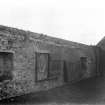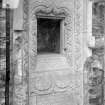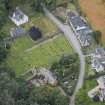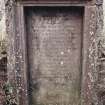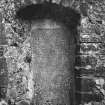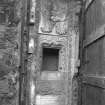Pricing Change
New pricing for orders of material from this site will come into place shortly. Charges for supply of digital images, digitisation on demand, prints and licensing will be altered.
Deskford, Old Parish Church, Sacrament House And Burial Ground
Burial Ground (Medieval), Church (15th Century), Holy Well (Medieval)
Site Name Deskford, Old Parish Church, Sacrament House And Burial Ground
Classification Burial Ground (Medieval), Church (15th Century), Holy Well (Medieval)
Alternative Name(s) St John's Church; Deskford Sacrament House; Deskford, St John's Well; Kirkton Of Deskford, Old Church Of St John And Burial Ground
Canmore ID 17977
Site Number NJ56SW 1
NGR NJ 50885 61660
NGR Description Centred NJ 50885 61660
Datum OSGB36 - NGR
Permalink http://canmore.org.uk/site/17977
- Council Moray
- Parish Deskford
- Former Region Grampian
- Former District Moray
- Former County Banffshire
NJ56SW 1 centred 50885 61660
(NJ 5088 6165) Church (NR) (In Ruins)
OS 6" map, Banffshire, 2nd ed., (1905)
(NJ 5090 6164) St John's Well (NR) (Site of)
OS 25" map, Banffshire, (1902)
For (adjacent) Tower of Deskford, see NJ56SW 2.
St John's Church is first mentioned in 1541, but as a 'chapel' at which time it was partly rebuilt. It is first described as a 'church' in 1545 (MacGibbon and Ross 1896-7). It possesses a rich sacrament house added in 1551 (Childe 1961).
In 1872, when the new church was built, the old church was unroofed but the walls were cemented for preservation and the sacrament house was boarded over to protect it.
The church is a long narrow building, orientated, with an outside stair at each end that led to the gallery.
A well, dedicated to St John, was near the church, but is now drained (Anon 1884).
All that remains of this well is a hollow space in the old wall between the church and the tower (NJ56SW 2) (ONB 1866).
Deskford Old Kirk and Sacrament House.
Ordnance Survey Name Book (ONB) 1866; Anon 1884; D MacGibbon and T Ross 1896-7; V G Childe 1961.
The church, with sacrament house intact, is as described above, except that there are no traces of the outside stairs remaining.
There is no trace of St John's Well. The siting information provided by the Name Book (1866) and incorporated on the OS 25" map, (1902), is incorrect; the 'hollow space in the old wall' is in fact a blocked entrance.
Visited by OS (WDJ) 18 September 1961.
No change.
Visited by OS (NKB) 27 July 1967.
Scheduled with (adjacent) Tower of Deskford (NJ56SW 2).
Information from Historic Scotland, scheduling document dated 20 February 1997.
INVENTORY OF GRAVEYARD AND CEMETERY SITES IN SCOTLAND REFERENCE:
Address: Deskford Burial Ground; Kirktown of Deskford, Moray
Postcode: AB56 5UA
Status: In current use for burials
Size: 0.23 hectares, 0.56 acres
Polygon: Yes
TOIDs: 1000000173491197, 1000000173491202, 1000000173491237, 1000000173491252, 1000000173491272
Number of gravestones: Not known
Earliest gravestone: Not known
Most recent gravestone: Not known
Description: Graveyard associated with a (no longer extant) church
Data Sources: OS MasterMap checked 30 June 2005; Bereavement Services Portal checked 30 June 2005
EXTERNAL REFERENCE
National Library Trans. Aberdeen Eccles, Soc, 1892, plate 1
Publication Account (1986)
The rather plain, old kirk of Desk ford stands near the healt of the lands of the powerful Ogilvie family, who rose to become Lords Deskford and finally Earls of Findlater and SeafIeld. Within the kirk is a finely carved late Gothic sacrament house presented by Alexander Ogilvie of that ilk and his wife in 1551. This small aumbry or recess was used for the reservation of the consecrated elements of the mass and is decorated with two angels holding a monstrance (in which the host was displayed), a running vine and side pinnacles. Of more modern, Renaissance, fonn are the scrolls for the inscription, the heraldry and the corbels. Presented by a local magnate, this is an example of the emphasis on personal salvation through church endowment that was a prominent feature of the late medieval church.Alexander Ogilvie and his wife are buried in Cullen collegiate church (no. 50), to which they also presented a sacrament house.
Information from ‘Exploring Scotland’s Heritage: Grampian’, (1986).
Publication Account (1996)
The rather plain, old kirk of Deskford stands near the heart of the lands of the powerful Ogilvie family, who rose to become Lords Deskford and finally Earls of Findlater and Seafield. Within the kirk is a finely carved late Gothic sacrament house presented by Alexander Ogilvie of that ilk and his wife in 1551. This small aumbry or recess was used for the reservation of the consecrated elements of the mass and is decorated with two angels holding a monstrance (in which the host was displayed), a running vine and side pinnacles.
Of more modern, Renaissance, form are the scrolls for the inscription, the heraldry and the corbels. Presented by a local magnate, this is an example of the emphasis on personal salvation through church endowment that was a prominent feature of the late medieval church. Alexander Ogilvie and his wife are buried in Cullen collegiate church (no. 50), to which they also presented a sacrament house.
Information from ‘Exploring Scotland’s Heritage: Aberdeen and North-East Scotland’, (1996).































































